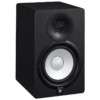Passing and auxiliary revolutions for solving harmony problems
Contents
Many people have difficulty solving problems on harmony, and the reason for this is not a lack of theoretical knowledge on the subject, but a certain confusion: there are quite a lot of chords covered, but which of them to choose for harmonization is a problem… My article, for which I I tried to collect all the most famous, frequently used passing and auxiliary phrases.
I’ll say right away that all examples relate to diatonic. This means that there are no phrases with “Neapolitan harmony” and double dominant here; we will deal with them separately.
The range of chords covered is the main triads with their inversions, sixth chords of the second and seventh degrees, seventh chords with inversions – dominant, second degree and introductory. If you don’t remember what steps chords are built on, then use a cheat sheet – copy the table for yourself from here.
What is a passing turnover?
Passing revolution is a harmonic sequence in which a passing chord of another function is placed between a chord and one of its inversions (for example, between a triad and its sixth chord). But this is just a recommendation, and by no means a rule. The fact is that the extreme chords in this sequence can also belong to completely different functions (we will see such examples).
It is much more important that another condition be fulfilled, namely, a progressive ascending or descending movement of the bass, which in the melody may correspond to a countermovement (most often) or a parallel movement.
In general, you understand: the most important thing in a passing turn is the progressive movement of the bass + if possible, the upper voice should mirror the movement of the bass (i.e. if the movement of the bass is ascending, then the melody should have a movement along the same sounds, but descending) + along possibilities, the passing chord must connect chords of the same function (i.e. inversions of the same chord).
Another very important condition is that the passing chord is always played on a weak beat (on a weak beat).
When harmonizing a melody, we recognize the passing revolution precisely by the progressive tertian movement of the melody up or down in compliance with the rhythmic conditions of this conduction. Having discovered the possibility of including a passing revolution in a problem, you can rejoice, only for a short time, so that in your joy you do not forget to write the bass and mark the corresponding functions.
The most common passing revolutions
Passing turn between the tonic triad and its sixth chord
Here the dominant quarter-sex chord (D64) acts as a passing chord. This turnover is shown both in a wide and in a close arrangement. The norms of voice production are as follows: the upper voice and bass move opposite to each other; the D64 doubles the bass; type of connection – harmonic (in the viola the general sound of G is maintained).
Between the tonic and its sixth chord, you can also place other passing chords, for example, a dominant third chord (D43), or a seventh sixth chord (VII6).
Pay attention to the peculiarities of voice leading: in rotation with D43, in order to avoid doubling the third in T6, it was necessary to move the seventh of D43 to the 5th degree, and not to the 3rd, as expected, as a result of which in the upper voices we have a pair of parallel fifths ( ), according to the rules of harmony in this turn their use is permissible; in the second example, in the passing sixth chord of the seventh degree (VII6), the third is doubled; this case should also be remembered.
A passing fourth-sex chord between the subdominant and its sixth chord
We can say that this is a similar example compared to the first passer that we looked at. The same norms of voice performance.
Passing revolution between the second degree triad and its sixth chord
This turn is used only in major, since in minor the triad of the second degree is minor. The triad of the second degree generally belongs to the category of rarely introduced harmonies; the sixth chord of the second degree (II6) is used much more often, but in a passing revolution its appearance is very pleasant.
Here you should note that in the sixth chord of the second degree itself (in II6), as well as in the passing tonic sixth chord (T6), you need to double the third! Also, especially with a wide arrangement, you need to check the harmonization more carefully for the appearance of parallel fifths (they are completely useless here).
In bars 3-4, the possibilities of connecting the subdominant (S64) and second degree (II6) sixth chords with passing T6 are shown. Pay attention to the voicing in the middle voices: in the first case, the jump in the tenor is caused by the need to avoid the appearance of parallel fifths; in the second case, in II6, instead of a third, a fifth is doubled (for the same reason).
Passing revolutions with a second stage seventh chord
In addition to the actual passages of this seventh chord between inversions, various variants of “mixed” turns are possible – using subdominant and dominant harmonies. I advise you to pay attention to the last example with a passing fourth sixth chord (VI64) between the main seventh chord and its fifth sixth chord (II7 and II65).
Passing revolutions between chords of the opening seventh chord
There are many possible variations of passing revolutions involving different chords. If tonic harmony becomes the passing chord, then you should pay attention to the correct resolution of the opening seventh chords (doubling the third is mandatory): incorrect resolution of the tritones that are part of the diminished opening chord can cause the appearance of parallel fifths.
It is interesting that passing harmonies of the subdominant function (s64, VI6) can be placed between the chords of the opening seventh. A superb version is obtained if you take the usual dominant as a passing chord.
What is an auxiliary turnover?
Auxiliary revolutions differ from passing ones in that the auxiliary chord connects two identical chords (actually a chord and its repetition). The auxiliary chord, like the passing chord, is introduced at a weak beat time.
Auxiliary harmonic rotation often occurs on sustained bass (but again, not necessarily). Hence the obvious convenience of its use in bass harmonization (another method of rhythmic fragmentation, along with simple chord movement).
I will show very few auxiliary revolutions and very simple ones. This is, of course, S64 between the tonic (similarly, the tonic quartet-sex chord between the dominant). And another very common one is II2, it is convenient to use it after resolving D7 into an incomplete triad, in order to restore the full structure.
We’ll probably end here. You can write these phrases down for yourself on a piece of paper, or you can simply save the page in your bookmarks – sometimes phrases like these really help out. Good luck in solving the puzzles!



